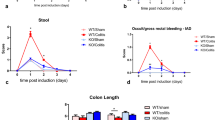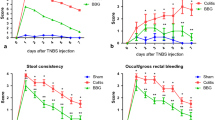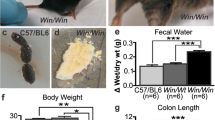Abstract
BACKGROUND AND PURPOSE: The intestine is rich in peptidergic innervation, which modulates mucosal immune responses. Among neuropeptides, substance P (SubP) has received considerable attention for stimulatory effects on various immunocytes in inflammatory diseases. In our prior study, we demonstrated increased innervation of SubP containing nerve fibers (SubP fibers) in ulcerative colitis (UC) surgically resected colonic specimens. In the present study, we examined the alterations of SubP fibers among various subgroups of UC, divided according to clinicopathologic features. METHODS: Distribution of SubP fibers were examined immunohistochemically in the rectal biopsy specimens of UC. The UC group was further divided into subgroups according to six clinicopathologic parameters. The linear density of SubP fibers was measured by digitalized morphometry for quantitative analysis. RESULTS: Multivariate analysis revealed significant correlations between linear density of SubP fibers vs.activity of diseases and total dose of prednisolone. Linear density was significantly increased in active cases of UC (active UC, 22.6±1.6 μm/1,000 μm 2;vs.inactive UC, 12.2±0.8 μm/1,000 μm 2;P<0.01). Furthermore, the increase was pronounced in cases that showed persistent inflammation and, accordingly, needed a high dose or continuous administration of prednisolone. CONCLUSION: Alterations in SubP fibers appear to play an important role in the pathogenesis of UC.
Similar content being viewed by others
References
MacDermott RP, Stenson WF. Alterations of the immune system in ulcerative colitis and Crohn's disease. Adv Immunol 1988;42:285–328.
Shanahan F, Anton P. Neuroendocrine modulation of the immune system. Dig Dis Sci 1988;33:41–9.
Martin FC, Anton PA, Gornbein JA, Shanahan F, Merrill JE. Production of interleukin 1 by microglia in response to substance P: role for a non-classical NK-1 receptor. J Neuroimmunol 1993;42:53–60.
Polak JM, Bloom SR. The neuroendocrine design of the gut. J Clin Endocrinol Metab 1979;8:313–30.
O'Doriso MS. Neuropeptides and gastrointestinal immunity. Am J Med 1986;81:74–82.
O'Doriso MS, O'Doriso TM, Cataland S, Balcerzak SP. VIP as a biochemical marker for polymorphonuclear leukocytes. J Lab Clin Med 1980;96:666–72.
Goetzl EJ, Chernov-Rogan T, Cooke MP, Renold F, Payan DG. Endogenous somatostatin-like peptides of rat basophilic leukemia cells. J Immunol 1985;135:2707–12.
Goetzl EJ, Chernov T, Renold F, Payan DG. Neuropeptide regulation of the expression of immediate hypersensitivity. J Immunol 1985;135:802–5.
O'Doriso MS, Wood CL, O'Doriso TM. Vasoactive intestinal peptide and neuropeptide modulation of the immune response. J Immunol 1985;135:792–6.
Costa M, Patel Y, Furness JB, Arimura A. Evidence that some intrinsic neurons of the intestine contain somatostatin. Neurosci Lett 1977;6:215–22.
Mayer EA, Raybould H, Koelbel C. Neuropeptides, inflammation, and motility. Dig Dis Sci 1988;33(Suppl):S71–7.
Miller RJ. New perspectives on gut peptides. J Med Chem 1984;27:1239–45.
Payan DG, Hess CA, Goetzl EJ. Inhibition by somatostatin of the proliferation of T-lymphocytes and molt-4 lymphoblasts. Cell Immunol 1984;84:433–8.
Kubota Y, Ottaway CA, Petras RE, Tubbs RR, Farmer RE, Fiocchi C. Loss of vasoactive intestinal polypeptide (VIP) immunoreactive nerve fibers in the colon of inflammatory bowel disease patients. In: Macdonald TT, Challacombe SJ, Blanca PW, Stokes CR, Hestly RV, Mowat AM, eds. Advances in mucosal immunology. London: Kluwer Academic Publishers, 1989:717–8.
Sjolund K, Schaffalitzky de Muckadell OB, Fahrenkrug J, Hakanson R, Peterson BG, Sundler F. Peptide-containing nerve fibers in the gut wall in Crohn's disease. Gut 1983;24:724–33.
Bishop AE, Polak JM, Bryan MG,et al. Abnormalities of vasoactive intestinal polypeptide-containing nerves in Crohn's disease. Gastroenterology 1980;79:853–60.
Watanabe T, Kubota Y, Sawada T,et al. Substance P and mucosal inflammation in ulcerative colitis [abstract]. Gastroenterology 1933;104(Suppl):798.
Kubota Y, Petras RE, Ottaway CA, Tubbs RR, Farmer RG, Fiocchi C. Colonic vasoactive intestinal peptide nerves in inflammatory bowel disease. Gastroenterology 1992;102:1242–51.
Koch TR, Carney JA, Go VL. Distribution and quantitation of gut neuropeptides in normal intestine and inflammatory bowel diseases. Dig Dis Sci 1987;32:369–76.
Dawson J, Bryant MG, Bloom SR, Peters TJ. Gastrointestinal regulatory peptide storage granule abnormalities in jejunal mucosal diseases. Gut 1984;25:636–43.
Metwai A, Blum AM, Ferraris L, Klein JS, Fiocchi C, Weinstock JV. Eosinophils within the healthy or inflamed human intestine produce substance P and vasoactive intestinal peptide. J Neuroimmunol 1994;52:69–78.
McCafferty DM, Sharkey KA, Wallace JL. Beneficial effects of local or systemic lidocaine in experimental colitis. Am J Physiol 1994;266:G560–7.
Reubi JC, Mazzucchelli L, Laissue JA. Intestinal vessels express a high density of somatostatin receptors in human inflammatory bowel disease. Gastroenterology 1994;106:951–9.
Surrenti C, Renzi D, Garcea MR, Surrenti E, Salvadori G. Colonic vasoactive intestinal polypeptide in ulcerative colitis. J Physiol (Paris) 1993;87:307–11.
Bemmstein CN, Robert ME, Eysselein VE. Rectal substance P concentrations are increased in ulcerative colitis but not in Crohn's disease. Am J Gastroenterol 1993;88:908–13.
Koch TR, Carney JA, Morris VA, Go VL. Somatostatin in the idiopathic inflammatory bowel diseases. Dis Colon Rectum 1988;31:198–203.
Kubota Y, Ptras RE, Tubbs RR, Farmer RG, Fiocchi C, Ottaway CA. Loss of vasoactive intestinal polypeptide immunoreactive nerve fibers in the colon of inflammatory bowel disease patients. In: Tsuchiya M, Nagura H, Hibi T, Moro I, eds. Frontiers of mucosal immunology. Amsterdam: Excerpta Medica, 1991:843–6.
Payan DG, Brewster DR, Goetzl EJ. Specific stimulation of human T lymphocytes by substance P. J Immunol 1983;131:1613–5.
Stanisz AM, Befus D, Bienenstock J. Differential effects of vasoactive intestinal polypeptide, substance P, and somatostatin on immunoglobulin synthesis and proliferations by lymphocytes from Peyer's patches, mesenteric lymph nodes, and spleen. J Immunol 1986;136:152–6.
Hagermark O, Hokfelt T, Pernow B. Flare and itch induced by substance P in human skin. J Invest Dermatol 1978;71:233–5.
Lembeck F, Holzer P. Substance P as neurogenic mediator of antidromic vasodilatation and neurogenic plasma extravasation. Naunyn Schmiedebergs Arch Pharmacol 1979;310:175–83.
Mandahl A, Bill A. Ocular responses to antidromic trigeminal stimulation, intracameral prostaglandin E1 and E2, capsaicin and substance P. Acta Physiol Scand 1981;112:331–8.
Lembeck F. Substance P and sensory neurones. In: Jordan CC, Oehme P, eds. Substance P metabolism and biological actions. London: Taylor & Francis, 1985:137–51.
Levine JD, Moskowitz MA, Basbaum AI. The contribution of neurogenic inflammation in experimental arthritis. J Immunol 1985;135:843–6.
Lotz M, Carson DA, Vaughan JH. Substance P activation of rheumatoid synoviocytes: neural pathway in pathogenesis of arthritis. Science 1987;235:893–5.
Mantyh PW, Catton MD, Boehmer CG,et al. Receptors for sensory neuropeptides in human inflammatory diseases: implications for the effector role of sensory neurons. Peptides 1989;10:627–45.
Keranen U, Kiviluoto T, Jarvinen H, Back N, Kivilaakso E, Soinila S. Changes in substance P immunoreactive innervation of human colon associated with ulcerative colitis. Dig Dis Sci 1995;40:2250–8.
Levine JD, Clark R, Devor M, Helms C, Moskowitz MA, Basbaum AI. Intraneuronal substance P contributes to the severity of experimental arthritis. Science 1984;226:547–9.
Watanabe T, Kubota Y, Sawada T, Muto T. Distribution and quantification of somatostatin in inflammatory disease. Dis Colon Rectum 1992;35:488–94.
Author information
Authors and Affiliations
About this article
Cite this article
Watanabe, T., Kubota, Y. & Muto, T. Substance P containing nerve fibers in rectal mucosa of ulcerative colitis. Dis Colon Rectum 40, 718–725 (1997). https://doi.org/10.1007/BF02140903
Issue Date:
DOI: https://doi.org/10.1007/BF02140903




